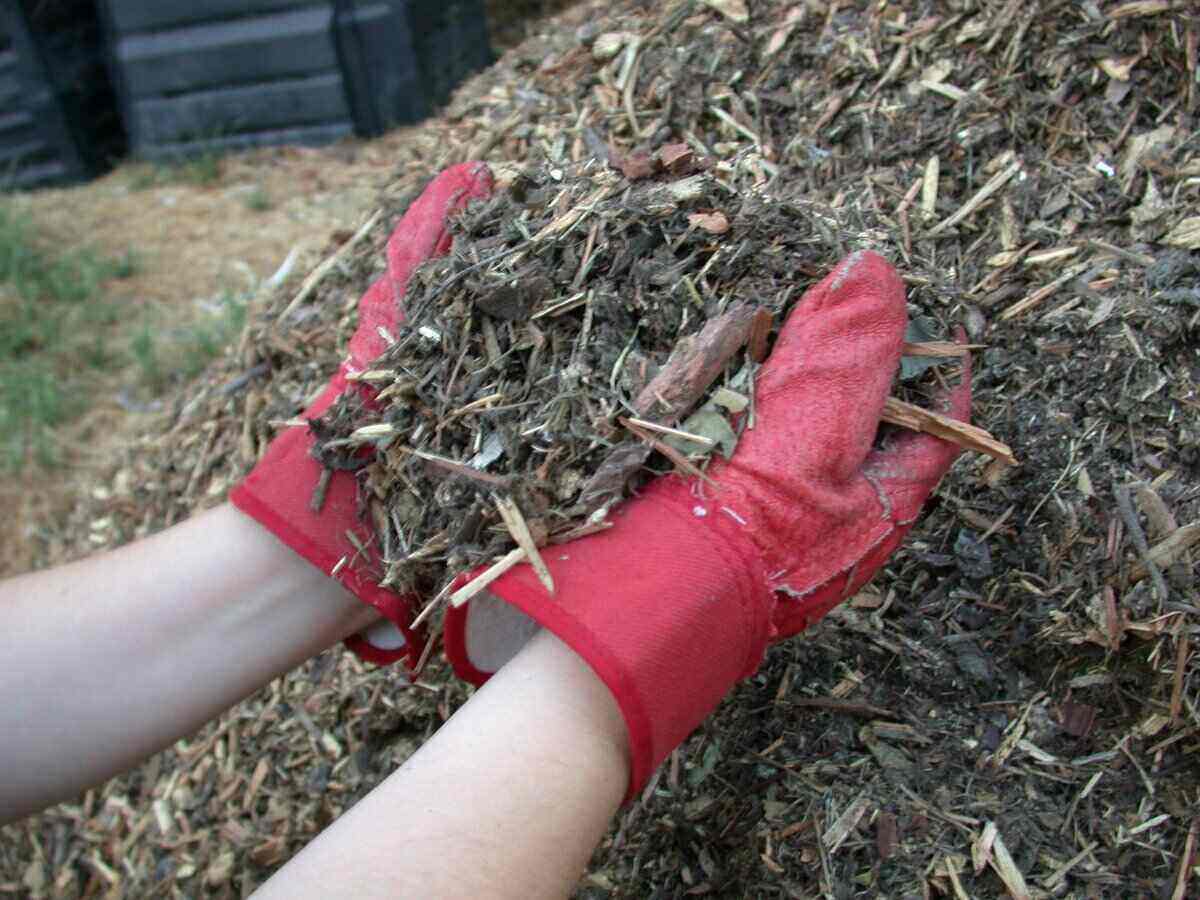
Once you have your landscaping and garden plants planted, they need protection from dastardly weeds and harsh weather. Mulch is one of the best ways to keep weeds away, keep your plants healthy and thriving, and increase curb appeal. But what are the different types of much, and which one is best for your landscape project?
What is mulch?
Mulch is a material you spread throughout your landscape to prevent erosion, insulate soil, and retain soil moisture for healthy plant growth. Mulch protects your soil and strengthens tree roots, grass, and garden plants. Plus, the right mulch can give your landscape loads of aesthetic appeal.
Mulch prices vary from free shredded grass clippings or leaves for your flower bed to pricier kinds like rubber mulch for your backyard playground. The average mulch installation costs about $200.
To choose the best mulch for your outdoor project, you have to first decide whether you want organic or inorganic mulch.
Organic mulch vs. inorganic mulch
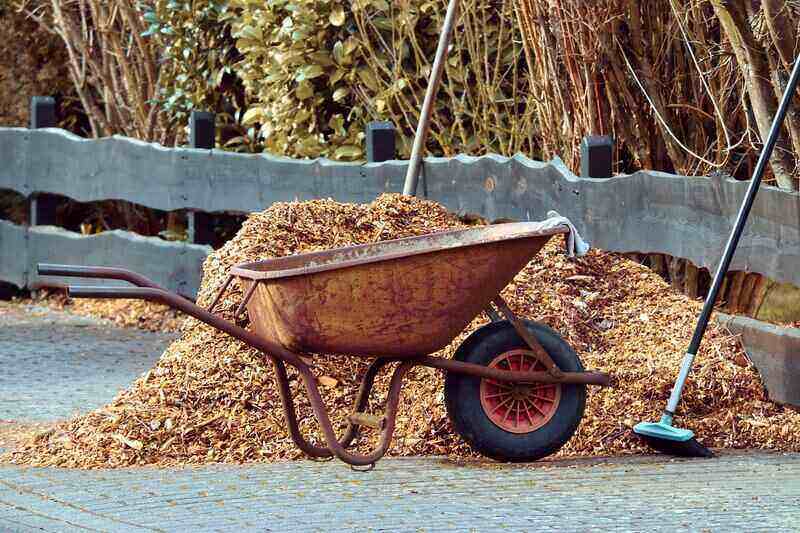
Organic mulches are best for homeowners who want to give their lawn a long-lasting nutrient infusion, while inorganic mulches are best for preventing weeds and enhancing your yard’s appearance.
Which one is best for you? This can be a tough decision, but here are some pros and cons of organic and inorganic mulch to consider:
Pros of organic mulch
✓ Increases soil quality and nutrient levels for lasting plant health
✓ Improves soil structure and texture
✓ Invites beneficial microorganisms and earthworms
✓ Costs less than inorganic mulches
✓ Stabilizes eroded areas
✓ Won’t overheat your garden
Cons of organic mulch
✗ Requires routine replacement
✗ May contain weed seeds (especially grass clippings and straw mulch)
✗ Can deplete soil surface nitrogen levels
✗ Moist wood mulches can attract pests like termites and roaches
Pros of inorganic mulch
✓ Long-lasting (does not decompose)
✓ Doesn’t include weed seeds
✓ Doesn’t deplete nitrogen in the soil
✓ Eye-catching and versatile
✓ Doesn’t invite pests
Cons of inorganic mulch
✗ Stone mulches settle deep in your soil
✗ Rock mulch absorbs and reflects heat
✗ Plastic sheeting prevents the flow of air and water
✗ Landscape fabric can suffocate worms
Types of organic mulch
Because organic mulches were once alive, they slowly decompose on your lawn over time. The decomposition of organic material gives your lawn, flower garden, and vegetable garden the added benefit of nutrients and attracts soil superstars like earthworms and beneficial microbes.
Wood
Wood mulch is usually made as a by-product of lumber mills and comes in three types: wood chips, wood nuggets, and bark. Wood mulch types vary in size, quality, and make-up, and the price usually reflects all three. You can purchase wood mulch directly from the lumber mill or at any home improvement store.
Wood chips
Wood chips are shredded or ground wood. Depending on the quality, the mulch can come from the inner trees, the bark, the branches, and the leaves. It’s the most common type of mulch due to its affordability. It lasts about five to seven years, though many homeowners give their garden beds a thin, fresh layer every spring for aesthetics.
Best use: Gardens or pathways
Colors: Black, brown, or red
Cost: $3 to $7 per bag
Thickness: 2 inches deep
Wood nuggets
Wood nuggets are very similar to wood chips but bigger. Like chips, the size and grade of wood nuggets vary by manufacturer. Because of the size, wood nuggets last longer than wood chips — about seven to 10 years, but many people freshen their mulch with a thin coat in the spring. You should know that they have a lower pH than chips, so they’re good for acidic-loving plants
Best use: Gardens or pathways
Colors: Brown, black, red, gold
Cost: $4 to $12 per bag
Thickness: 2 inches deep
Wood bark
Bark mulch is higher-quality mulch, made only of tree bark and not all the other bits and pieces. It can be ground or shredded, making it aesthetically pleasing. It’s also available as bark chips. Because it’s made of the durable outside of the tree, bark mulch lasts about seven to 10 years. Some homeowners will spruce up their bark mulch with a thin, fresh coat in the spring.
Best use: Pathways, and around trees or shrubs or in flower beds with minimal digging Colors: Brown, red, black
Cost: $30 to $100 per cubic yard
Thickness: 2 inches deep
Straw
Using straw mulch, especially in your garden, helps retain moisture and prevents soil compaction. Straw consists of the hollow stalks left over from wheat, barley, and rye harvests. Don’t confuse straw with hay, though, as hay contains dried-out weeds and their seeds, while straw contains no seeds at all. Straw can usually be purchased at your local hardware store.
Best use: Protecting germinating vegetables, flowers, and grass seeds and seedlings in spring or over dormant plants in the late fall/early winter
Colors: Usually non-colored, natural yellowish-tan, but available in red, brown, black
Cost: $30 to $40 per cubic yard
Thickness: 2 to 8 inches deep, depending on the use
Pine needles
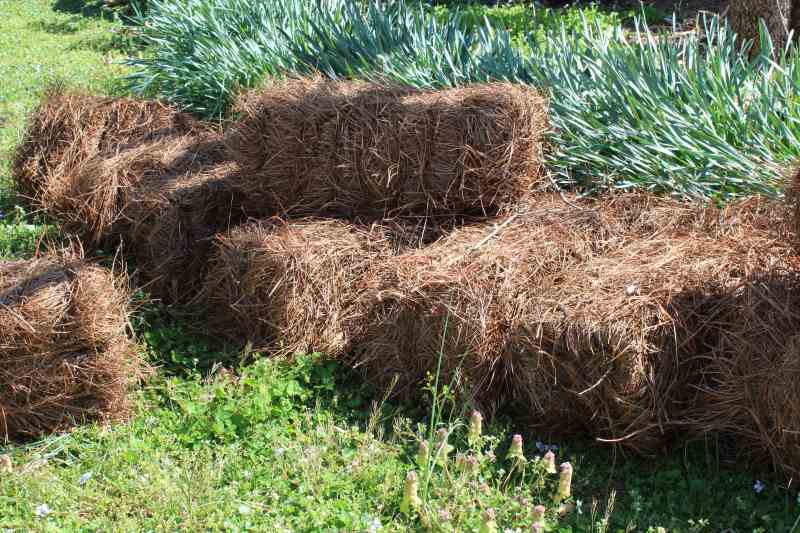
Pine needles, also known as pine straw, is an excellent mulch for flower beds. It’s light and doesn’t compact as it decomposes. It helps prevent weeds, evaporation, and erosion. Pine needles also insulate the ground, stabilizing the soil temperature.
Best use: Best for flower or vegetable gardens, but also great around trees and shrubs
Colors: Usually non-colored, natural light brown, but available in red and brown
Cost: Averages $16 per bag, but free if you can gather them from your yard
Thickness: 2 inches deep
Compost
Compost is a mixture of organic waste, such as food scraps and garden trimmings, that has decomposed into dark, nutrient-rich dirt. Compost happens naturally in the wild, but you can do it at home too. It saves money on waste disposal and mulch, and it’s good for the environment too.
Adding a thick layer of compost, or “black gold,” is an excellent way to choke out weeds while giving your plants important nutrients like nitrogen and carbon. Best of all, compost is environmentally friendly and free. Unfortunately, compost doesn’t last forever and breaks down quickly, so you’ll need to add more compost to your garden every month or so.
If you decide to compost at home, you can compost:
- Teabags
- Coffee grounds
- Eggshells
- House plants
- Ashes from the fireplace
- Leaves
- Grass clippings
- Fur and hair
- Fruits and vegetables
- Shredded cardboard and newspaper
- Wool or cotton fabric cut into small strips
Don’t compost:
- Meat trimmings
- Fatty foods, meat, or oils
- Pet waste
- Charcoal or coal ash
- Bones
- Anything treated with chemicals
- Black walnut tree debris
Best use: Excellent for anywhere there are plants, but particularly beneficial for flower beds and vegetable gardens
Colors: Depends on what’s in your mulch, but usually dark brown
Cost: $20 to $50 per cubic yard, or free if you make your own
Thickness: 1 to 2 inches
Grass clippings

Instead of tossing your grass clippings, you can let them lay where they fall to nourish your turfgrass or bag them up and spread them in your garden beds. Grass clippings are nitrogen-heavy, feeding your plant life at no cost to you.
However, there are a few things to remember if you use grass clippings as mulch.
- If it’s longer than 1 inch, don’t leave it on your lawn. They can smother your grass.
- Don’t mulch with herbicide-treated grass.
- Don’t mulch with grass containing disease.
- Don’t mulch with grass clippings containing weeds.
While grass clippings are an excellent source of nutrients and help retain moisture, they break down quickly, so they won’t be the most effective way to keep weeds at bay.
Best use: On lawns, but also excellent for flower and vegetable gardens
Colors: Green, then turns to brown
Cost: Free from your lawn
Thickness: 1 to 2 inches
Shredded leaves
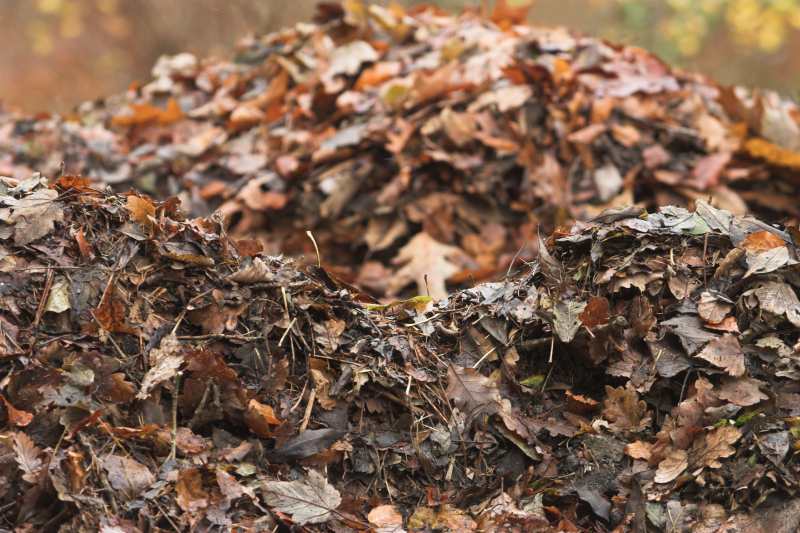
Like grass clippings, shredded leaves, also known as leaf mulch, are a wonderful way to add nutrients to your soil, retain moisture, and reduce erosion. On your lawn, you can just mow over them, and they quickly decompose, boosting your grass. For your garden, shred the leaves in a barrel using your weed wacker and spread them around your plants.
You may be wondering if you can just let the fallen leaves be and decompose where they fall. The answer is no. Whole fallen leaves are too big and will block out the sunlight, killing your grass or causing mold or fungus to grow.
Best use: Anywhere there are plants, including lawns, flower beds, vegetable gardens, and around trees and shrubs
Colors: Naturally brown to dark brown, but red is available
Cost: $15 to $35 per bag, or free if you use your own leaves
Thickness: 2 inches
Newspaper
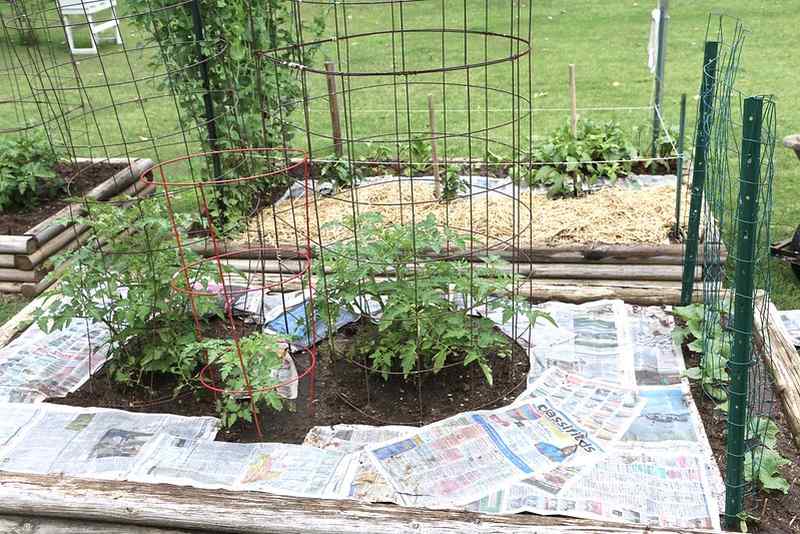
If you have old newspapers lying around, a perfect use for them is to use them as a landscape fabric alternative. Laying the papers down around your plants blocks out the sun, smothering weeds. Many homeowners use them in conjunction with other organic mulches like grass clippings or compost.
If you don’t have any newspapers lying around, there are lots of places that give away their old ones for free, including:
- Hotels
- Coffee shops
- Grocery Stores
- Libraries
- Recycling centers
- Newspaper printers or distributors
Best use: Flower beds or vegetable garden
Colors: Gray, black and white
Cost: Free
Thickness: About 5 pages thick
Cardboard
Like newspaper, cardboard is a great way to keep weeds out. Laying your spare boxes around your landscaping plants effectively prevents weeds by blocking the sun and helping to prevent new weeds from seeding, all while feeding your plants with the decomposing organic matter. It’s an eco-friendly and free way to recycle the boxes lying around your house.
If you don’t keep boxes lying around, you can try getting them from:
- Pharmacies
- Costco or other big box stores
- Recycling centers
- Schools
- Fast food restaurants
- Grocery stores
Best use: Flower beds or vegetable garden
Colors: Light brown
Cost: Free
Thickness: One layer of cardboard
Coco coir
Made from ground coconut husks, coco coir (also referred to as coco mulch) is carbon-rich, balancing out nitrogen-heavy soils. It’s often used as a pH soil neutralizer due to its relatively neutral pH ( 5.5-6.8). Because it’s fibrous, it also helps soil that is heavy with sand or clay. This eco-friendly mulch has excellent water retention and lasts up to three years.
Best use: Flower beds, vegetable gardens, or potted plants.
Colors: Normally a rich brown, but can be dyed in other colors
Cost: $4 to $7 per brick
Thickness: 2 to 3 inches
Cocoa bean mulch
Made from cocoa bean shells, cocoa bean mulch gives off a rich, dark chocolate aroma, and the deep color is aesthetically pleasing. The mulch helps retain moisture and block out weeds. Cocoa mulch contains nitrogen, phosphate, and potash, boosting your soil’s nutrients. However, it shouldn’t be kept too wet as it attracts pests, and its theobromine is toxic to dogs.
Best use: Flower beds, vegetable gardens, or around trees and shrubs
Colors: Dark brown
Cost: $15 to $35 per bag
Thickness: 1 to 2 inches
Types of inorganic mulch
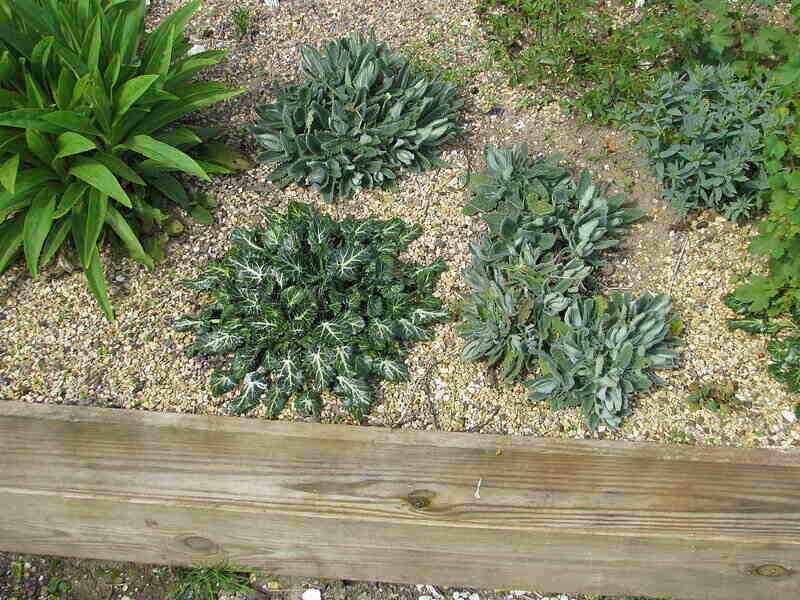
Inorganic mulches can be natural or synthetic, but the materials are never alive, so they don’t decompose. This means you don’t have to replace them as frequently as organic mulches, but it also means they don’t return nutrients to the soil.
Stones
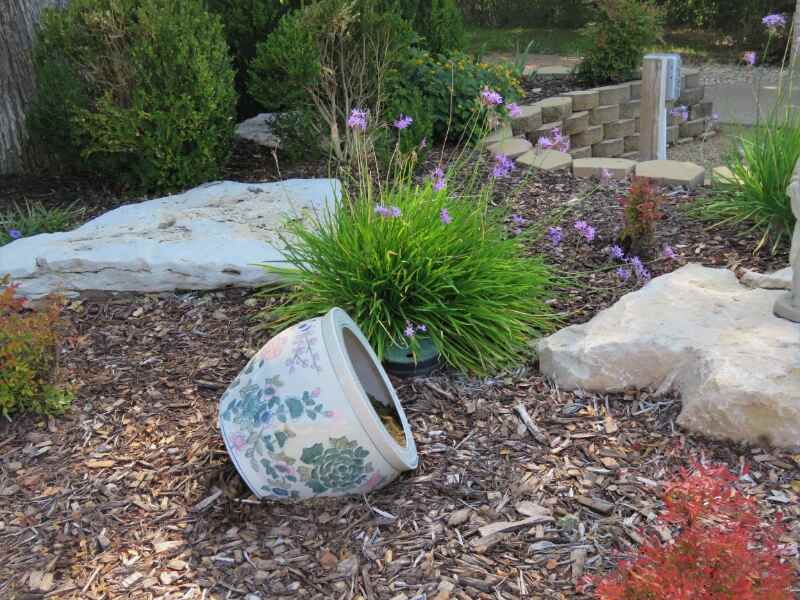
Using stone as mulch has many benefits, including aesthetics, low maintenance, and long lifespan. Because it won’t be washed away, stone mulch is perfect for hillsides, steep terrain, along your foundation, and around trees and shrubs. Conversely, don’t use it where you plant often because the stones will be lost in the dirt, turning your soil rocky.
There’s a huge range of stone types, including:
- Pea Gravel
- Brick chips
- River rocks
- Lava rocks
- Beach pebbles
- Marble chips
Best use: Around trees and shrubs, in hardscaping and walkways
Colors: Nearly any color, but most commonly on the grayscale or red
Cost: Depending on the kind you get, $15 to $750 per cubic yard
Thickness: 1 to 2 inches
Rubber

Made from recycled rubber, rubber mulch has pros and cons. It comes in many colors, provides cushion, and lasts for up to 10 years. It’s low maintenance, reduces erosion, won’t attract pests, and prevents weeds. However, rubber mulch is often made from recycled tires, so it’s flammable and has a distinct, rather unpleasant odor.
Best use: Around trees and shrubs, in hardscaping and children’s play areas
Colors: Most colors, but most commonly blue, green, black, brown, red
Cost: $17 to $68 per cubic yard
Thickness: 1 to 2 inches
Crusher dust
Measuring 5 mm or smaller, crusher dust is made from recycled stone and concrete. Also called cracker dust, quarry sand, stone dust, or rock dust, it’s primarily used for hardscapes, walkways, and other masonry projects. While not optimal as the primary mulching method, you can add crusher dust to your soil, garden, and lawn to improve drainage, aid aeration, and increase pH.
Best use: Hardscapes and pathways or sprinkled on lawns and gardens
Colors: On the grayscale, black, blue-gray, brown, red
Cost: $10 to $25 per cubic yard
Thickness: 10 to 15 cm
Landscape fabric and landscape plastic
Both landscape fabric and landscape plastic are laid over your soil to prevent weeds from popping up in your flower bed. Typically, you make space for desirable plants, like perennials, to sprout while the weeds are deprived of water, sunlight, and air. Both types can be found at your local garden center or home improvement store.
Differences between landscape fabric and landscape plastic
- Permeability: While there are many types of landscape fabric, most are made from a woven material, allowing some water and air through. Plastic is typically a solid sheet of plastic, preventing any water and air from seeping in.
- Lifespan: On average, plastic has a shorter lifespan because the sunlight causes it to break down. Thicker plastic increases the lifespan, but the fabric will last longer.
- Aesthetics: There’s no way around it. Landscape fabric usually looks nicer than landscaping plastic over your garden.
- Cost: Landscape plastic is more cost-effective than landscape fabric.
- Ease of use: Landscape plastic is most often easier to install than landscape fabric.
- Weed suppression: Landscape plastic is better at suppressing weeds but also may stifle plant growth.
Best use: Gardens with little digging, or around trees and shrubs
Colors: Black, green, or brown, natural burlap color (fabric), black (plastic)
Cost: $0.20 to $0.24 per square foot for fabric, and plastic is slightly less expensive
Thickness: One layer
Benefits of mulch
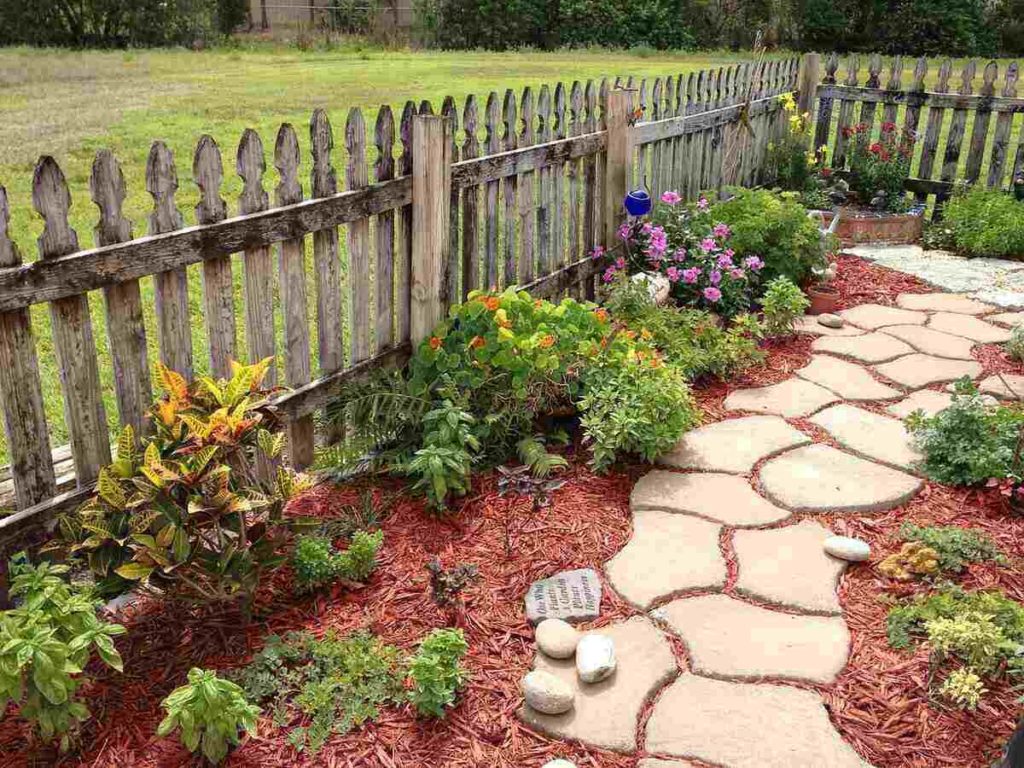
Mulch offers a treasure trove of benefits, which is why landscapers, gardeners, and soil experts swear by mulch.
Benefits of both organic and inorganic mulch include:
- Reduces evaporation: Keeps soil moist, reducing evaporation so you won’t have to water as frequently.
- Prevents soil compaction: Stops soil from being trampled, keeping grass green and lush and reducing your aeration needs.
- Prevents frost heaving: Frost heaving (the repeated freezing and thawing process that pushes plants out of the ground and damages roots).
- Prevents weed growth: Trees, shrubs, and flowers don’t have to compete with unwanted plants for nutrients.
- Adds visual appeal: Mulch is a favorite decoration among landscapers and gardeners. It gives your yard texture and a pop of color.
- Increases root growth: Plant roots can extend into the mulch instead of being confined to the soil.
- Slows disease: Prevents the spread of soil-borne diseases by reducing soil splash during rainstorms. Fungal and bacterial diseases from soil splash can cause leaf discoloration, wilting, and plant death.
- Protects plants: Protects trees and shrubs from mowing damage, so roots and bark stay healthy and intact.
- Reduces soil erosion: Slows erosion from wind and rain, keeping the soil surface permeable and protecting your ecosystem from harmful runoff.
When should you apply mulch?
You can apply mulch at any time of the year, but it’s most beneficial to spread mulch in the middle of spring. Here’s why: Plants will thrive with a layer of fresh mulch as their roots warm up and begin their most vigorous growth period.
FAQ about different types of mulch
Which mulch is best for gardens?
Usually, for gardens, your best option is an organic mulch. Organic mulches retain moisture, provide nutrients, and increase soil health while also keeping the weeds at bay.
However, if you have a xeriscape or other very low-maintenance garden types, or if your weeds are extreme, you’re probably better off with inorganic mulch.
Can I use landscape fabric and wood mulch together?
You shouldn’t use landscape fabric and wood mulch together. Landscape fabric inhibits the water and nutrients from the wood to be absorbed into the soil and by the plants.
Does the color of my mulch matter?
To some degree, yes, the color of your mulch matters. Depending on your climate, the color of your mulch can dry out, or water log your plants.
- Dark-colored mulch: Black and dark brown mulch absorbs sunlight. If you live in a cooler climate, darker mulch can help heat your garden. If you live in a warm climate, only use dark mulch in a heavily shaded area.
- Light-colored mulch: Tan or white mulches reflect the sunlight, keeping your garden cooler. It’s a good choice for hot climates or for plants that prefer a cooler environment.
The color of your mulch also makes a difference in aesthetics, highlighting, blending, and plant stimulation.
Hire a professional to mulch your yard
From beautiful stones to nutrient-rich compost, mulch can be a feast for your eyes and your soil. But even if you’re a garden enthusiast, you can feel overwhelmed by the choice and the task itself. You’re not alone. Homeowners nationwide struggle to find the time, energy, or drive to create a beautifully mulched landscape.
If you want a luxurious outdoor space but need a helping hand, Lawn Love can help. We’ll connect you with an experienced, highly-rated, local professional who’ll craft the environment you’re looking for without breaking the bank.
Main Photo Credit: Dvortygirl | Wikimedia Commons | CC BY-SA 3.0